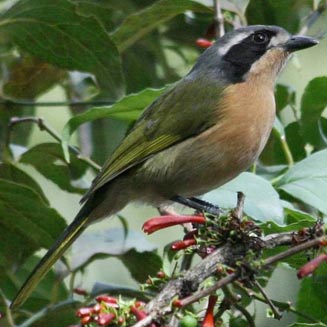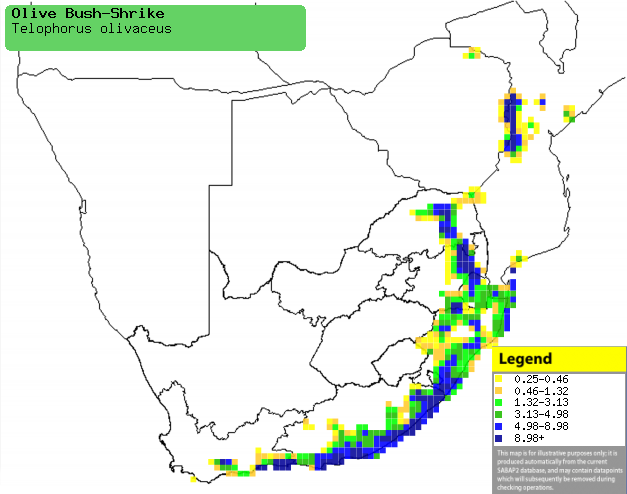|
Telophorus olivaceus (Olive bush-shrike)
Olyfboslaksman [Afrikaans]; Umthethi (also applied
to Black cuckooshrike - CHECK) [Xhosa]; Olijfgroene bosklauwier
[Dutch]; Gladiateur olive [French]; Olivwürger [German];
Picanço-oliváceo [Portuguese]
Life
> Eukaryotes
>
Opisthokonta
> Metazoa
(animals) > Bilateria > Deuterostomia >
Chordata > Craniata > Vertebrata (vertebrates) > Gnathostomata (jawed
vertebrates) > Teleostomi (teleost fish) > Osteichthyes (bony fish) > Class:
Sarcopterygii (lobe-finned fish) > Stegocephalia (terrestrial vertebrates) >
Tetrapoda (four-legged vertebrates) > Reptiliomorpha > Amniota >
Reptilia
(reptiles) > Romeriida > Diapsida > Archosauromorpha > Archosauria >
Dinosauria (dinosaurs) > Saurischia > Theropoda (bipedal predatory
dinosaurs) > Coelurosauria > Maniraptora > Aves (birds) >
Order: Passeriformes
> Family: Malaconotidae
 |
|
|
Olive bush-shrike male in Halleria lucida
tree, Queen Elizabeth Park, Pietermaritzburg, South Africa. [photo
Alan Manson
©] |
|
For information about this species, see
www.birdforum.net/opus/Olive_Bush_Shrike
Distribution and habitat
Near-endemic to southern Africa, occurring in Zimbabwe's
eastern highlands bordering on Mozambique, as well as in southern Malawi. In
South Africa it is fairly common, occupying the area from Limpopo Province,
Mpumalanga and KwaZulu-Natal along the coast to the Eastern and Western Capes.
In Zimbabwe's eastern highlands it prefers Afromontane forest, but in South
Africa it can also be found in evergreen forest, dense woodand, thickets in
valley bushveld and riverine forest.
|
 |
|
Distribution of Olive bush-shrike in southern Africa,
based on statistical smoothing of the records from first SA Bird Atlas
Project (©
Animal Demography unit, University of
Cape Town; smoothing by Birgit Erni and Francesca Little). Colours range
from dark blue (most common) through to yellow (least common).
See here for the latest distribution
from the SABAP2. |
Food
It mainly eats insects, doing most of its foraging in the
tree canopy, gleaning insects from leaves and twigs, descending to lower levels
at the forest's edge. It also regularly joins mixed species foraging flocks. The
following food items have been recorded in its diet:
- Insects
-
spiders
- Small fruit, including figs (Ficus)
Breeding
- The nest is built by both sexes, and consists of a flimsy, untidy saucer
built of fine dry grass, leaf stems and dried flowers.
- Egg-laying season is from about October-January, peaking during
November.
- It lays 1-2 eggs, which are incubated by both sexes for about 18 days.
- The chicks are cared for both parents, leaving the nest after about
16-17 days.
Threats
Not threatened.
References
-
Hockey PAR, Dean WRJ and Ryan PG 2005. Roberts - Birds of
southern Africa, VIIth ed. The Trustees of the John Voelcker Bird Book
Fund, Cape Town.
|
